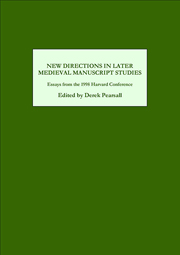Book contents
- Frontmatter
- Contents
- List of Illustrations
- Acknowledgements
- Introduction
- Recent Directions in Medieval Manuscript Study
- Another Fine Manuscript Mess: Authors, Editors and Readers of Piers Plowman
- A New Approach to the Witnesses and Text of the Canterbury Tales
- Prospecting in the Archives: Middle English Verse in Record Repositories
- Medieval Manuscripts and Electronic Media: Observations on Future Possibilities
- Representing the Middle English Manuscript
- Skins, Sheets and Quires
- Reconsidering the Auchinleck Manuscript
- Professional Readers of Langland at Home and Abroad: New Directions in the Political and Bureaucratic Codicology of Piers Plowman
- Professional Scribes? Identifying English Scribes Who Had a Hand in More Than One Manuscript
- Manuscript Production in Medieval Theatre: The German Carnival Plays
- The ‘Lancelot-Graal’ Project
- After Chaucer: Resituating Middle English Poetry in the Late Medieval and Early Modern Period
- Notes on Contributors
- Index
Manuscript Production in Medieval Theatre: The German Carnival Plays
Published online by Cambridge University Press: 05 September 2014
- Frontmatter
- Contents
- List of Illustrations
- Acknowledgements
- Introduction
- Recent Directions in Medieval Manuscript Study
- Another Fine Manuscript Mess: Authors, Editors and Readers of Piers Plowman
- A New Approach to the Witnesses and Text of the Canterbury Tales
- Prospecting in the Archives: Middle English Verse in Record Repositories
- Medieval Manuscripts and Electronic Media: Observations on Future Possibilities
- Representing the Middle English Manuscript
- Skins, Sheets and Quires
- Reconsidering the Auchinleck Manuscript
- Professional Readers of Langland at Home and Abroad: New Directions in the Political and Bureaucratic Codicology of Piers Plowman
- Professional Scribes? Identifying English Scribes Who Had a Hand in More Than One Manuscript
- Manuscript Production in Medieval Theatre: The German Carnival Plays
- The ‘Lancelot-Graal’ Project
- After Chaucer: Resituating Middle English Poetry in the Late Medieval and Early Modern Period
- Notes on Contributors
- Index
Summary
If you were fortunate enough to be living in the city of Lübeck between 1430 and 1540, then in its glory days as queen of the Hanseatic League, you could have witnessed the performance of about two hundred carnival plays. Some were the usual kind, called Einkehrspiele, that young men put on in many German towns. In a medieval form of home invasion, costumed mummers would go from house to house and perform brief sketches before carnival revelers gathered in a large room. In Lübeck, most players were choristers from the four church schools, making the rounds in groups of two to six, often led by their teachers. Their playlets dramatized traditional comic themes: the wicked old hag, the widow too easily comforted, here comes the judge, the marriage game. These plays, some eighty in number, have all been lost. We know about them because one carnival theatre stop was the clubhouse of a merchant confraternity – called Greveradenkompanie after its founder – whose stewards recorded the tips paid out to carnival ‘rhymers’ (rymers), as they refer to them, in the company book of 1495 to 1539 that happens to survive.
That the hand of time is hard on light student sketches is perhaps not surprising. But in Lübeck, carnival playmaking was also the concern of men who governed the largest and most powerful north German city and ran its trading economy, its merchants and administrators. They socialized and protected their interests in two elite confraternities. The old money belonged to the Squire Company or Confraternity of the Zirkel, meaning ‘compass’, an emblem symbolic of the Trinity. The new rich who hoped to become Squires one day joined the Merchant Company. Both confraternities produced carnival plays and staged them on wagons drawn to the marketplace.
- Type
- Chapter
- Information
- New Directions in Later Medieval Manuscript StudiesEssays from the 1998 Harvard Conference, pp. 143 - 166Publisher: Boydell & BrewerPrint publication year: 2000

